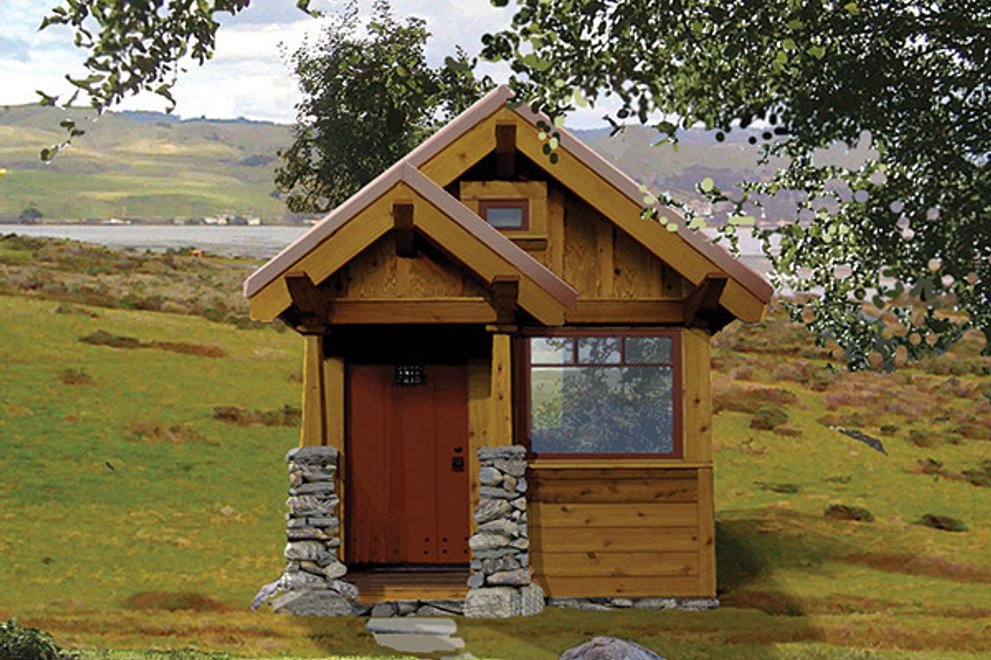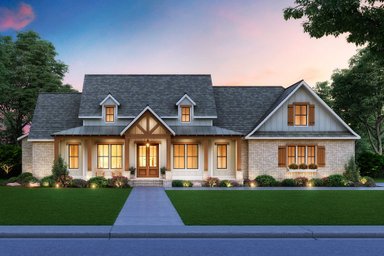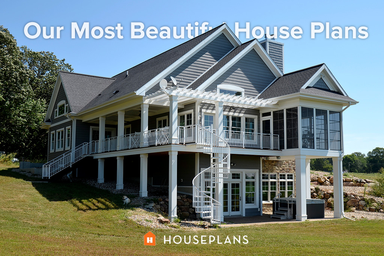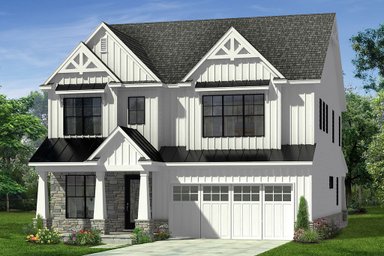Architect Jim Cutler and
his 11-year-old daughter, Hannah, recently built this tiny cabin 30 feet from
their main house and were delighted to discover just how much a part of their
family’s daily ritual this bunkhouse/design studio/family room has become. Working together on weekends, Cutler, FAIA,
principal of Cutler Anderson Architects on Bainbridge Island,
Washington, and Hannah began building the cabin in September 2015,
when Hannah was 10, and finished it in June 2016.
Made of rough-sawn Douglas fir two-by-fours milled at a local sawmill, the cabin measures approximately 80 square feet, which is roughly the
size of the old toolshed it replaces, and is clad in hand-cut, 22-gauge Cor-Ten steel shingles. Inside, the cabin serves as a bunkhouse for Hannah’s sleepovers,
with two twin bunk beds (one is shown here) that easily fold up and down on traction struts that Hannah can handle herself. The space is also Cutler’s design
studio. After years of doing work for clients from his kids’ playroom in the basement, Cutler designed this cabin in part to give himself a water view and a more palpable connection to his natural environment. Although Cutler and Hannah built
most of the cabin themselves, the drafting desk, drawers and cabinets were crafted by Kory Mathis of Korben Mathis Woodworking. A cast iron wood-burning stove by Salamander Stoves that measures 12 inches wide by 12 inches deep by 16 inches high keeps the cabin toasty on cold winter days, and a 2.2-cubic-foot refrigerator keep drinks cool. In case the power goes out, there is a 4.5-kilowatt backup power system for the cabin, consisting of four golf-cart batteries and related equipment, which Cutler and Hannah wired themselves. The cabin could easily be converted
to solar power, although Cutler says there is not enough light filtering through the surrounding woods in winter to power the cabin during that season. In the evenings, the cabin becomes a family room where Cutler draws at his desk while his wife, Beth, and Hannah pull down a bunk bed and read or watch movies on the 32-inch computer monitor/TV screen. And, at some point, this cabin
may even have a fourth use as a poker room for Cutler and his friends. The front door, which is made of Douglas fir, includes a door lever designed by Cutler.
I recently sat down with Cutler and asked him more about the project.
What was it like designing and building this cabin with your daughter?
“There’s nothing like being 67 years old and having an 11-year-old to build a building with. Designing and building this tiny cabin together was as much fun for me as designing a federal high rise building in Portland. One endeavor took 1,000 people to make it happen; the other took an 11-year-old and a semi-skilled laborer—me. I want to expose Hannah to all sorts of things, I want her to make things.
Hannah and I hand dug the foundation, and Beth and Hannah dug the footings. I precut the forms in the garage, and Hannah screwed them together with a screw gun. She also liked tying the steel. When we poured the foundation, we did it in a bucket using bags of ready-mix concrete. Hannah wasn’t so good at pouring, but she enjoyed screeding all the forms. Hannah was also good at laying the subfloor. Basically, we built the building inside out with the studs exposed, carried sections to the site from the garage, and Hannah screwed it all together and bolted it down.
I didn’t let her on the roof, which took two months on weekends to do, but she helped with all the metal siding by holding it level while I put the screws in or vice versa. We installed Appleton junction boxes, and Hannah pulled the wire through on all four of them. I don’t want to exaggerate, I did the lion’s share of the process, but she was very involved.”
What tips do you have for other parents who want to build a tiny cabin with their kids? What’s on your Dos and Don’ts list?
“If there is anything my children have taught me, it’s patience. Even when your kids mess up, tell them they’re doing a good job. Everyone makes mistakes. Hannah drilled my hand once, and we put a Band-Aid on it and got right back to work. She’s thoughtful and accepting of her own failures, and I think that’s because we’ve taught her that mistakes are the way you learn. And now she knows that you can build something and the result is something you can use.”
What do you enjoy most about the cabin? Is there anything you would do differently if you had it to do over again?
“I like the whole place and how well it functions for my family. The way everyone uses it, which was unexpected. I also like the details—the new, rough-sawn Douglas fir, the giant sheet of glass and the way the beam sits behind the glass. There are little bits of craft that I’d do differently, such as the rafters are on eight-inch centers, but there is one that is off by one-half inch in one spot, and the chimney isn’t Cor-Ten steel, so it won’t last as long as the shingles. The only real negative I see is that our living room doesn’t get used as much now.”
Whether you’re building a tiny cabin with your kids or a full-size home, Cutler offers a word of advice about choosing exceptional rather than average. “While an average house might make you conform to its structure, an exceptional house organically becomes a part of your family’s daily life,” he says.
All photos courtesy of, and by, Art Grice.
To browse a collection of Tiny House Plans, click here. For a collection of Cabin Plans click here.
Made of rough-sawn Douglas fir two-by-fours milled at a local sawmill, the cabin measures approximately 80 square feet, which is roughly the
size of the old toolshed it replaces, and is clad in hand-cut, 22-gauge Cor-Ten steel shingles. Inside, the cabin serves as a bunkhouse for Hannah’s sleepovers,
with two twin bunk beds (one is shown here) that easily fold up and down on traction struts that Hannah can handle herself. The space is also Cutler’s design
studio. After years of doing work for clients from his kids’ playroom in the basement, Cutler designed this cabin in part to give himself a water view and a more palpable connection to his natural environment. Although Cutler and Hannah built
most of the cabin themselves, the drafting desk, drawers and cabinets were crafted by Kory Mathis of Korben Mathis Woodworking. A cast iron wood-burning stove by Salamander Stoves that measures 12 inches wide by 12 inches deep by 16 inches high keeps the cabin toasty on cold winter days, and a 2.2-cubic-foot refrigerator keep drinks cool. In case the power goes out, there is a 4.5-kilowatt backup power system for the cabin, consisting of four golf-cart batteries and related equipment, which Cutler and Hannah wired themselves. The cabin could easily be converted
to solar power, although Cutler says there is not enough light filtering through the surrounding woods in winter to power the cabin during that season. In the evenings, the cabin becomes a family room where Cutler draws at his desk while his wife, Beth, and Hannah pull down a bunk bed and read or watch movies on the 32-inch computer monitor/TV screen. And, at some point, this cabin
may even have a fourth use as a poker room for Cutler and his friends. The front door, which is made of Douglas fir, includes a door lever designed by Cutler.
I recently sat down with Cutler and asked him more about the project.
What was it like designing and building this cabin with your daughter?
“There’s nothing like being 67 years old and having an 11-year-old to build a building with. Designing and building this tiny cabin together was as much fun for me as designing a federal high rise building in Portland. One endeavor took 1,000 people to make it happen; the other took an 11-year-old and a semi-skilled laborer—me. I want to expose Hannah to all sorts of things, I want her to make things.
Hannah and I hand dug the foundation, and Beth and Hannah dug the footings. I precut the forms in the garage, and Hannah screwed them together with a screw gun. She also liked tying the steel. When we poured the foundation, we did it in a bucket using bags of ready-mix concrete. Hannah wasn’t so good at pouring, but she enjoyed screeding all the forms. Hannah was also good at laying the subfloor. Basically, we built the building inside out with the studs exposed, carried sections to the site from the garage, and Hannah screwed it all together and bolted it down.
I didn’t let her on the roof, which took two months on weekends to do, but she helped with all the metal siding by holding it level while I put the screws in or vice versa. We installed Appleton junction boxes, and Hannah pulled the wire through on all four of them. I don’t want to exaggerate, I did the lion’s share of the process, but she was very involved.”
What tips do you have for other parents who want to build a tiny cabin with their kids? What’s on your Dos and Don’ts list?
“If there is anything my children have taught me, it’s patience. Even when your kids mess up, tell them they’re doing a good job. Everyone makes mistakes. Hannah drilled my hand once, and we put a Band-Aid on it and got right back to work. She’s thoughtful and accepting of her own failures, and I think that’s because we’ve taught her that mistakes are the way you learn. And now she knows that you can build something and the result is something you can use.”
What do you enjoy most about the cabin? Is there anything you would do differently if you had it to do over again?
“I like the whole place and how well it functions for my family. The way everyone uses it, which was unexpected. I also like the details—the new, rough-sawn Douglas fir, the giant sheet of glass and the way the beam sits behind the glass. There are little bits of craft that I’d do differently, such as the rafters are on eight-inch centers, but there is one that is off by one-half inch in one spot, and the chimney isn’t Cor-Ten steel, so it won’t last as long as the shingles. The only real negative I see is that our living room doesn’t get used as much now.”
Whether you’re building a tiny cabin with your kids or a full-size home, Cutler offers a word of advice about choosing exceptional rather than average. “While an average house might make you conform to its structure, an exceptional house organically becomes a part of your family’s daily life,” he says.
All photos courtesy of, and by, Art Grice.
To browse a collection of Tiny House Plans, click here. For a collection of Cabin Plans click here.






